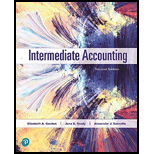
Convertible Bonds, Conversion. Using the information provided in E14-13, complete the following requirements assuming that the effective rate of interest for convertible bonds is 4% on the date of issue.
Required
- a. Determine the issue price of the debt.
- b. Prepare the amortization table for the bond issue assuming that Mobile Technology uses the effective interest rate method of amortization.
- c. Prepare the
journal entry when Mobile Technology issued the bonds. - d. Prepare the journal entry to record the first interest payment.
- e. The bonds converted on January 1, 2021. Prepare the journal entry to record the bond conversion.
E14-13. Convertible Bonds, Conversion. On January 1, 2018, Mobile Technology, Incorporated issued $650,000 of $1,000 par value, 6%, 6-year bonds. Interest is payable semiannually each January 1 and July 1 with the first interest payment due at the end of the period on July 1, 2018. The market rate of interest for similar non-convertible bonds on the date of the bond issue was 10%. However, because these bonds are convertible, the effective rate is 8%. Each bond is convertible into 20 shares of Mobile Technology’s $2 par value common stock. Assume there is no beneficial conversion option.
Required
- a. Determine the issue price of the debt.
- b. Prepare the amortization table for the bond issue assuming that Mobile Technology uses the effective interest rate method of amortization.
- c. Prepare the journal entry when Mobile Technology issued the bonds.
- d. Prepare the journal entry to record the first interest payment.
- e. The bonds converted on January 1, 2021. Prepare the journal entry to record the bond conversion.
Want to see the full answer?
Check out a sample textbook solution
Chapter 14 Solutions
Intermediate Accounting (2nd Edition)
- If a business pays off a loan, which of the following will occur?A. Assets and liabilities increaseB. Assets and liabilities decreaseC. Only liabilities increaseD. Equity decreasesarrow_forwardWhich financial statement lists revenues and expenses?A. Balance SheetB. Cash Flow StatementC. Income StatementD. Retained Earnings Statementneedarrow_forwardNo chatgpt! Which financial statement lists revenues and expenses?A. Balance SheetB. Cash Flow StatementC. Income StatementD. Retained Earnings Statementarrow_forward
- Which financial statement lists revenues and expenses?A. Balance SheetB. Cash Flow StatementC. Income StatementD. Retained Earnings StatementNo Aiarrow_forwardWhich financial statement lists revenues and expenses?A. Balance SheetB. Cash Flow StatementC. Income StatementD. Retained Earnings Statementarrow_forwardWhich account is a contra-asset?A. Accounts PayableB. Accumulated DepreciationC. Notes ReceivableD. Prepaid Rentcorrectarrow_forward
- Which account is a contra-asset?A. Accounts PayableB. Accumulated DepreciationC. Notes ReceivableD. Prepaid Rentcorrect solutuarrow_forwardWhich account is a contra-asset?A. Accounts PayableB. Accumulated DepreciationC. Notes ReceivableD. Prepaid Rentneedarrow_forwardWhich account is a contra-asset?A. Accounts PayableB. Accumulated DepreciationC. Notes ReceivableD. Prepaid Rentarrow_forward
- Choose the items of income or expense that belong in the described areas of Form 1120, Schedule M-1 (Sections: Income subject to tax not recorded on books, Expenses recorded on books this year not deducted on this return, Income recorded on books this year not included on this return, and Deductions on this return not charged against book income.) Note the appropriate amount for the item selected under each section. If the amount decreases taxable income relative to book income, provide the amount as a negative number. If the amount increases taxable income relative to book income, provide the amount as a positive number. The following adjusted revenue and expense accounts appeared in the accounting records of Pashi, Inc., an accrual basis taxpayer, for the year ended December 31, Year 2. Revenues Net sales $3,000,000 Interest 18,000 Gains on sales of stock 5,000 Key-man life insurance proceeds 100,000 Subtotal $3,123,000 Costs and Expenses Cost of…arrow_forwardPlease provide the accurate answer to this general accounting problem using valid techniques.arrow_forwardSolve this Question Accurate with General Accounting Solving methodarrow_forward
 Financial Accounting: The Impact on Decision Make...AccountingISBN:9781305654174Author:Gary A. Porter, Curtis L. NortonPublisher:Cengage Learning
Financial Accounting: The Impact on Decision Make...AccountingISBN:9781305654174Author:Gary A. Porter, Curtis L. NortonPublisher:Cengage Learning
